
Posted by Dr. Anil R. Shah
WHAT IS DEEP NECK LIFTING?
Deep neck and deep neck lifting is where you manipulate the deeper structures of the neck. Let’s define the structures of the neck before we get started.
The first layer we see is the skin. Then, right underneath the neck is fat. Most of the time when doctors do liposuction, they focus on this second layer of fat and guess what? Sometimes the neck looks better, and sometimes it does not.
Does removing more superficial fat lead to better neck contour? Oftentimes, it is the deeper layer of fat and underlying deeper structures which can create neck contour abnormalities. These structures can be shaped and modified but oftentimes not removed.
Ver esta publicación en InstagramUna publicación compartida por Rhinoplasty | Face Surgeon (@shahaesthetics)
Structure 1: Deep Fat of the Neck
Deep fat of the neck is most evident when seen at the bottom of the neck when flexing it downwards. This view can show volume which can be removed. Deep neck fat is seen below the muscle of the neck (platysma or muscular drape- article written by Dr Anil Shah) and can often be seen along the lateral portion of the neck. Removal of it can be challenging as there are various structures associated with it including blood vessels.

Structure 2: Digastric muscles
The digastric muscles are large muscles within the neck. These muscles can be either resected or reshaped to create a more desirable neck contour. The muscles attach to the hyoid bone of the neck.
Structure 3: Submandibular glands
The submandibular glands are the glands in your neck responsible for saliva. With age, the glands can descend and sometimes grow in size. These glands can create bulges. It is important to not remove the entire gland or this will lead to loss of lubrication in the mouth. The gland is surrounded by nerves and other structures so patients should seek only an experienced doctor specializing in faces for this type of procedure.
Structure 4: Hyoid bone
The hyoid bone is the only floating bone in the body and it helps define the neck angle. A lower hyoid can contribute to a poorly defined neck angle while a higher hyoid bone can create a much more contoured neck. Since the hyoid bone is floating, subtle changes in position can be accomplished with direct manipulation and sutures, creating a more contoured neck than though imaginable.
Structure 5: Base of tongue or the mylohyoid muscle
The mylohyoid muscle is where your tongue connects to the floor of mouth. While we need this structure, if it is too large it can lead to snoring and poor cosmesis of the neck. In select cases, Dr. Shah will modify this structure to help create an even more contoured neck.
The deeper neck structures are extraordinarily complicated structures to work with but they do allow for more dramatic neck contours and allow Dr. Shah to perform dynamic changes of the neck. This means even when patients put their head down, their neck will stick look reasonably good. Dr. Shah often prefers to leave some superficial fat on the neck skin (younger skin is thicker) and do mostly deeper neck modifications to create a beautiful neck.

